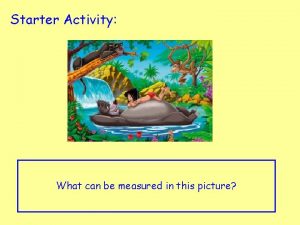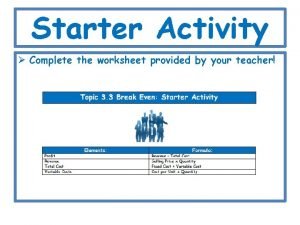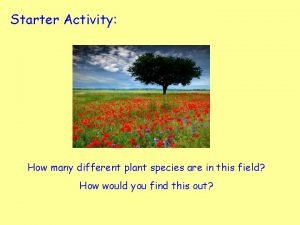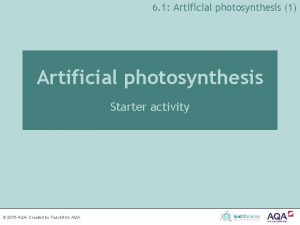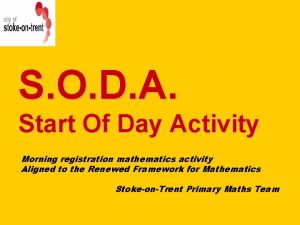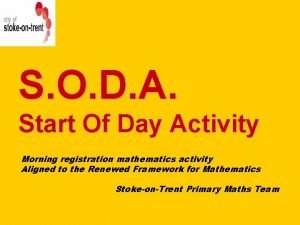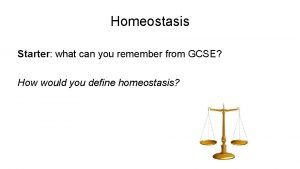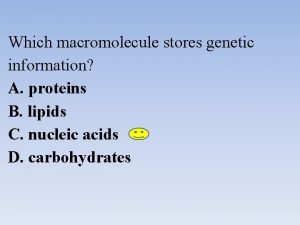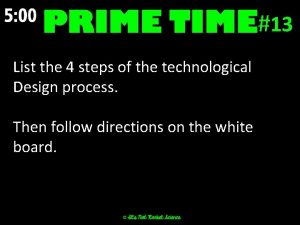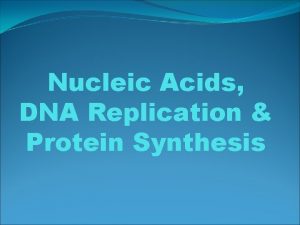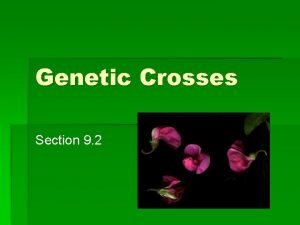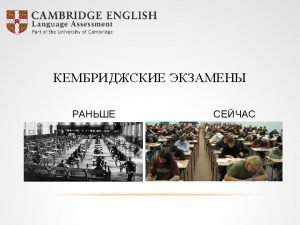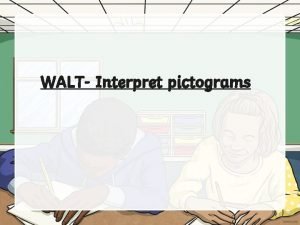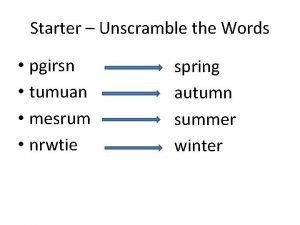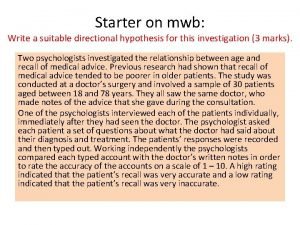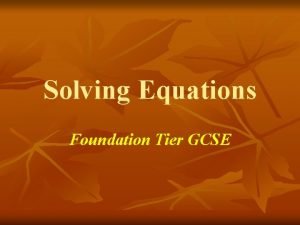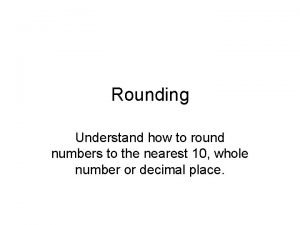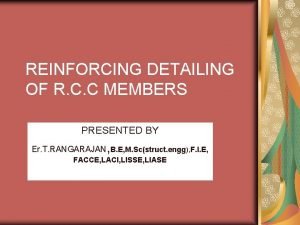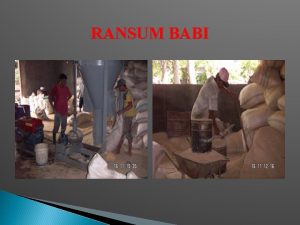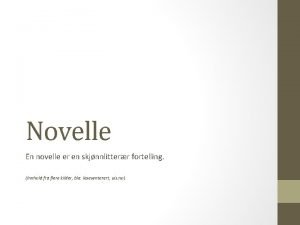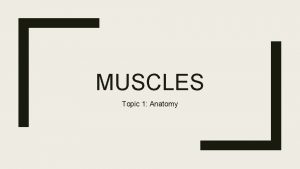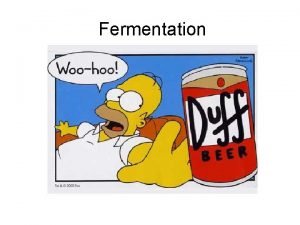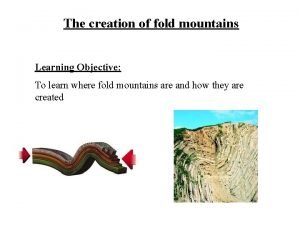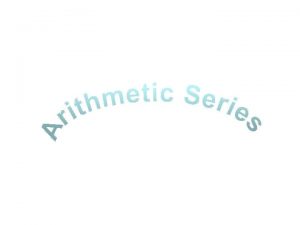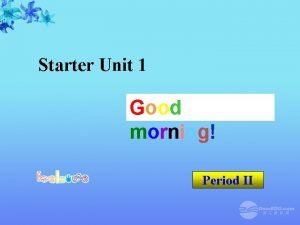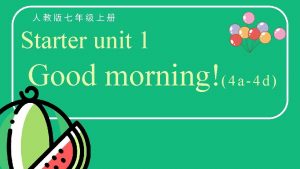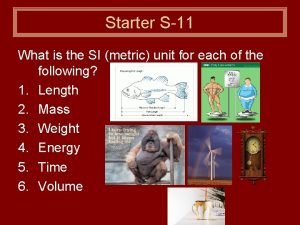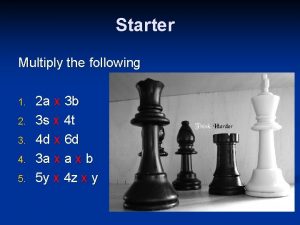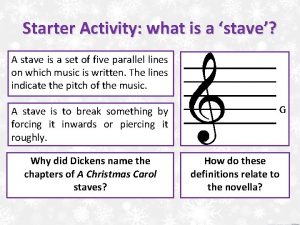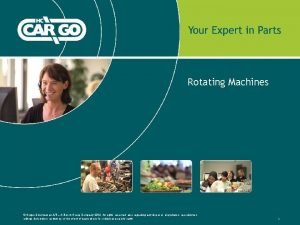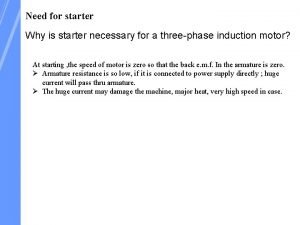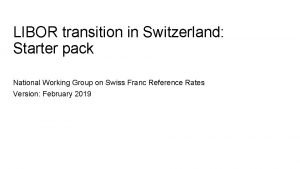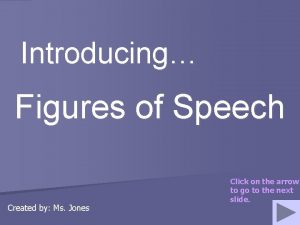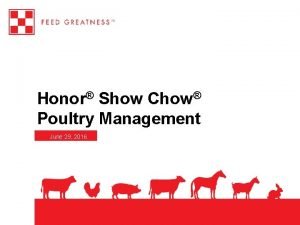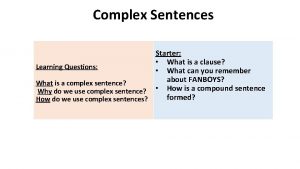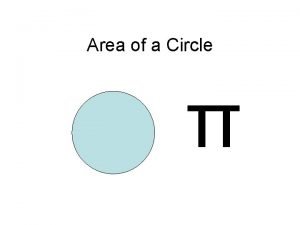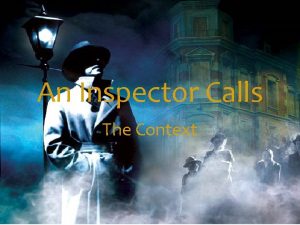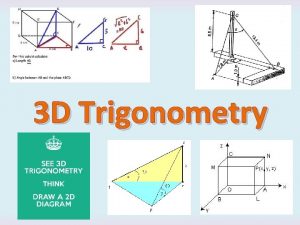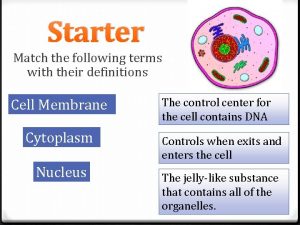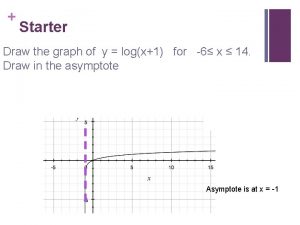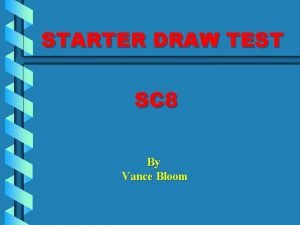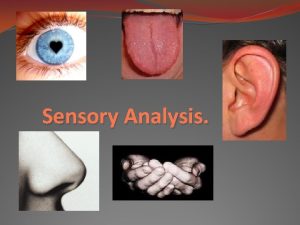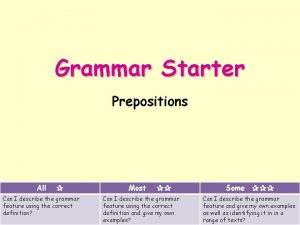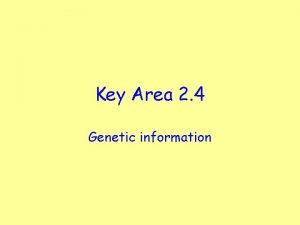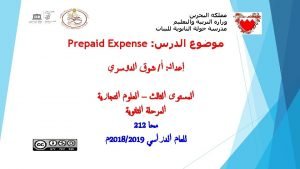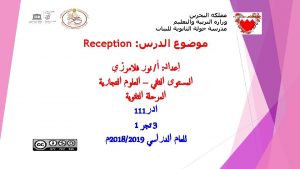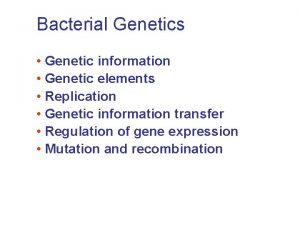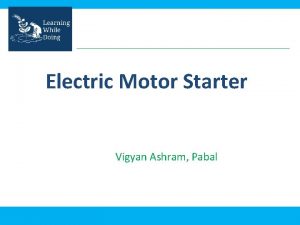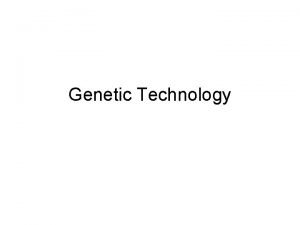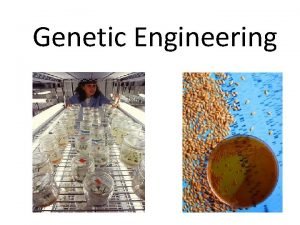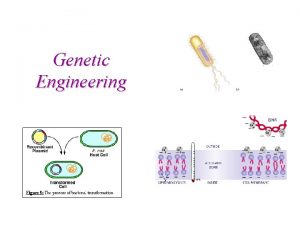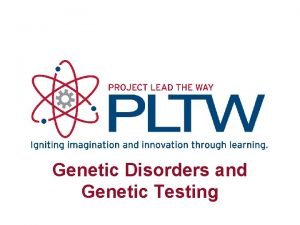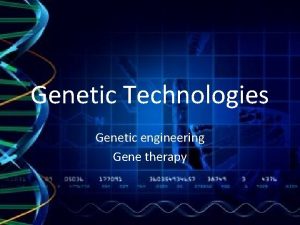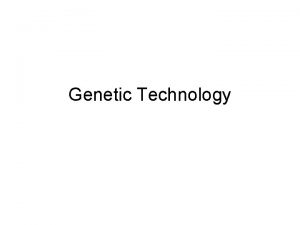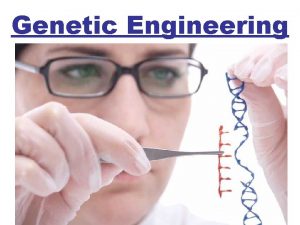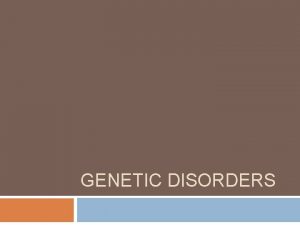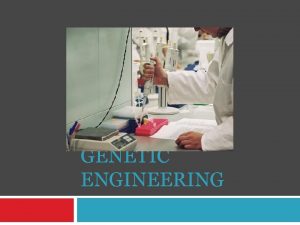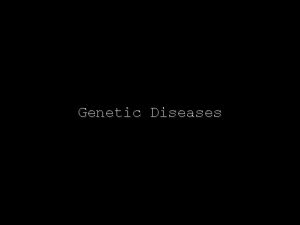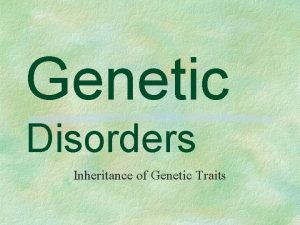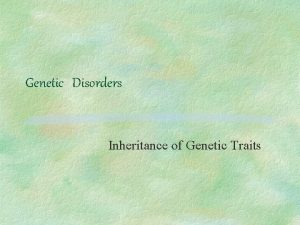Key Area 2 4 Genetic information Starter Activity




































































- Slides: 68

Key Area 2. 4 Genetic information

Starter Activity: Discuss the following questions with your partner: What are genes? Where in your cells are your genes found? What chemical makes up your genes? What physical characteristics are controlled by your genes?

Variation Learning Intention: To learn about how genes control the physical appearance of an organism Success Criteria: Be able to define the terms chromosome, DNA, gene and variation Understand that physical characteristics are inherited from biological parents through sections of DNA

Family resemblance Members of the same family often look similar. Which parent do these children look more like? Why do members of the same family look similar? Humans, like all organisms, inherit characteristics from their parents. How are characteristics passed on? Characteristics pass on through reproduction.

Species A species is a group of organisms who can interbreed and produce offspring which are fertile (able to reproduce). All humans can interbreed so we are all the same species.

Some unusual examples • Some animals seem to be members of the same species but are not. • The animals may be able to interbreed and produce young, but the young are not able to reproduce. • Two examples are mules and ligers.

X = A mule is infertile, so horses and donkeys are not the same species.


Variation • Although the members of a species are very similar to one another, they are not identical. • Variation occurs among members of a species.






Variation • Variation – differences that exist among members of a species.

What is variation? Differences due to inherited and environmental factors that exist between members of a species.

Human Variation Examples of human variation include: Height Blood group Weight Tongue rolling Handspan Handedness Shoe size Hair Colour Hair Type Fingerprints Freckles Eye Colour Heart Rate Twig Video: Human Variation

Variation Learning Intention: To learn about how genes control the physical appearance of an organism Success Criteria: Understand that physical characteristics are inherited from biological parents through sections of DNA

Starter

Variation For some characteristics there are clear groups of individuals. • Tongue rolling- can or cannot • Blood group – A, B, AB or O • Fingerprint patterns – whorls, loops, arches • Shape of leaves on oak trees – lobes, no lobes • Colour of petals on a flower • Seed colour in peas – green, yellow, brown

Variation graphs For any variation where the data gives distinct groups, a bar chart or pie chart can be used. NUMERACY

Human Variation You will look at examples of variation within the class and construct a table.

Activity 1 Complete the table in your booklet identifying the characteristics of people in the class. Name Ear lobes attached yes/no Freckles yes/no Tongue roll yes/no Left/right handed

Ear lobes attached yes/no Name Freckles yes/no Tongue roll yes/no Left/right handed Choose two of these variations, and draw a bar chart for each.

Measured variation For some characteristics there are not clear groups of individuals. Instead there is a broad range of measured values. • Height of rowan trees • Weight of rabbits • Pulse rate in humans • Leaf size in geraniums • Weight of chestnuts from tree • Height in humans

Range of heights and sizes

Variation graphs NUMERACY In this type of measured variation, most individuals have heights in the centre of the range, with few at the extremes. This type of graph is called a histogram or frequency graph.

Activity 2 Complete the table in your booklet showing the hand spans of people in the class. Then complete the summary table and histogram. Hand span (cm) Number of people Total number of people Less than 17. 5 18 18. 5 19. 5 20. 5 21. 5 22 or over

Hand span (cm) Total number of people Less than 17. 5 Number of people (tally mark) 17. 5 18. 5 19. 5 20. 5 21. 5 22 or over

Structure of DNA and Genes

Genetic information Learning Intention: To learn about how genes control the physical appearance of an organism Success Criteria: Be able to define the terms chromosome, DNA, gene and variation Understand that physical characteristics are inherited from biological parents through sections of DNA

What is DNA? • DNA stands for Deoxyribonucleic Acid. • DNA is found in the nucleus of a cell. • It is would up very tightly into structures called chromosomes.

Chromosomes • A chromosome is a threadlike structure that carries genetic information.


Gene

Genes • Chromosomes are split up into smaller segments called genes. • A gene is a section of a chromosome that contains a piece of genetic information e. g. the gene for tongue rolling. • We inherit half of our genes from our mother and half from our father. • This means that two genes control each characteristic.

How are genes inherited?

The parents Homer has straight hair Marge has curly hair

The families Is hair curliness controlled by genes or by the environment?

Homer • Homer has straight hair. • Every cell in Homer has two sets of genes. • Homer’s has two straight hair genes. • We can show the straight hair gene with a capital H. • Homer’s genes: HH.

Marge • Marge has curly hair. • Every cell in Marge has two sets of genes. • Marge has two curly hair genes. • We can show the straight hair gene with a small h. • Marge’s genes: hh

Making a new Simpson • Homer makes sperm. • Each sperm has one gene for hair type. • Homer only has straight hair genes. • So all of his sperm have straight hair genes. Homer’s Sperm H H

Making a new Simpson • Marge makes eggs. • Each egg has one gene for hair type. • Marge only has curly hair genes. • So all of her eggs have curly hair genes. Marge’s Eggs h h

Making a new Simpson h h H Hh Hh This type of diagram is called a punnet square.

Making a new Simpson Hh Hh • All of the Simpson babies have one gene for curly hair and one gene for straight hair • So what type of hair do they have?

Making a new Simpson Hh THEY ALL HAVE STRAIGHT HAIR! • The straight hair gene is DOMINANT. • Just one copy of this gene will give you that characteristic. • The curly hair gene is RECESSIVE. • You need two copies of the gene to have that characteristic.

Liking donuts • Homer likes donuts • Every cell in his body has two donut liking genes. • His genes are: D D Homer’s sperm D D

Liking donuts • Marge doesn’t like donuts. • Every cell in her body has two donut disliking genes • Her genes are: d d Marge’s Eggs d d

Making a new Simpson d d D Dd Dd

Making a new Simpson Dd Dd • Liking donuts is dominant • Do the Simpson children like donuts? Dd Dd

Weight • Marge has normal weight. • Both of her weight genes are for normal weight. • Her genes are: N N • If you have two identical genes, this is known as true breeding. Marge is true breeding for normal weight. Marge’s Eggs N N

Weight • Homer does not have normal weight. He is overweight. • Homer is true breeding for being overweight. This means both of his weight genes are for being overweight. • His genes are: n n Homer’s sperm n n

Making a new Simpson Nn Nn • Normal weight is dominant. • What weight do all the Simpson children have – normal or overweight?

Activity 3 – Homer and Marge Cross Number Homer’s genes Marge’s characteristic Marge’s genes 1 Likes beer BB Doesn’t like beer bb 2 Plays sports SS Doesn’t play sports ss 3 Burps BB Doesn’t burp bb 4 Lazy LL Not lazy ll For each of the above characteristics, work out what their children are likely to be like.

The next generation? • Lisa has straight hair. • Every cell in Lisa has two sets of genes. • Lisa has one gene for straight hair (H), which is dominant. • She also has one gene for curly hair (h), which is recessive. • Lisa is not true breeding. • Lisa’s genes: Hh

• Milhouse has straight hair. • Every cell in Milhouse has two sets of genes. • Milhouse has one gene for straight hair, which is dominant. • He also has one gene for curly hair, which is recessive, so he is not true breeding. • Milhouse’s genes: Hh

• Milhouse’s genes: Hh Milhouse’s sperm: H • Lisa’s genes: Hh H h Lisa’s eggs: h

The next generation? What if Lisa and Milhouse have children? H h H HH Hh hh

The next generation HH Hh Hh • Straight hair is dominant. • Imagine Lisa and Milhouse have 4 children. • How many children will have straight hair? • How many will have curly hair? hh

Activity 4 -The next generation Cross Number Lisa’s characteristic Lisa’s genes Milhouse’s characteristic Milhouse’s genes 1 Likes School Ss Like School Ss 2 Good eyesight EE Bad eyesight ee 3 Brave Bb Not brave bb For each of the above characteristics, work out what their children are likely to be like using the punnet squares in your worksheet. If you feel confident, you can try the extension exercise in the booklet.

Variation • We can see that not all of Lisa and Milhouse’s children would be the same. • This is because each child inherits a slightly different set of genes from their parents. • This creates variation within families, and variation within the population.

Starter

Say hello……to the Reebops

Activity 5 – Making Reebops 1. Open each envelope, take out the cards and sort them out into Mum’s (pink) and Dad’s (blue). 2. Sort each set of chromosomes into pairs of the same length. Now turn all the chromosomes over. 3. Randomly take one chromosome from each pair of Mum’s chromosomes and place in a pile called ‘female gamete’. 4. Randomly take one chromosome from each pair of Dad’s chromosomes and place in a pile called ‘male gamete’. 5. Put the unpicked chromosomes back in the envelope.

Fertilisation 1. Mix the two sets of chromosomes together. This is what happens in fertilisation. 2. Sort out the chromosomes into size again. 3. Use the decoder key to decide what characteristics your Reebop has. Write these in the table in your booklet. 4. Now you can make your Reebop!

Decoder key Characteristic antennae Decoder AA = 2 antennae Aa = 2 antennae aa = no antennae BB = 3 body segments Bb = 3 body segments bb = 2 body segments tail TT = curly tail Tt = curly tail tt = straight tail nose NN = red nose Nn = orange nose nn = yellow nose legs LL = blue legs Ll = blue legs ll = red legs sex XX = female (pink XY = male (non body) pink body) eyes EE = 2 eyes Ee = 2 eyes ee = one eye humps HH = 1 hump Hh = 1 hump hh = 3 humps body segments


Questions 1. Are there any baby Reebops that are identical? 2. How much genetic material does each parent provide? 3. How is this genetic material passed on to the children? 4. Why is there variation in families?
 Gene pool
Gene pool Genetic programming vs genetic algorithm
Genetic programming vs genetic algorithm Genetic programming vs genetic algorithm
Genetic programming vs genetic algorithm Genetic drift vs genetic flow
Genetic drift vs genetic flow Gene flow vs genetic drift
Gene flow vs genetic drift Starter activity clipart
Starter activity clipart Starter activity
Starter activity Quadrat sampling example
Quadrat sampling example Photosynthesis starter activity
Photosynthesis starter activity Starter of the day activity soda morning soft start
Starter of the day activity soda morning soft start Starter of the day activity soda morning soft start
Starter of the day activity soda morning soft start Homeostasis starter activity
Homeostasis starter activity Which macromolecule stores energy
Which macromolecule stores energy Stores hereditary information
Stores hereditary information Which macromolecule stores our genetic information? *
Which macromolecule stores our genetic information? * Flow of genetic information
Flow of genetic information Genetic vocabulary worksheet answer key
Genetic vocabulary worksheet answer key Crossing over occurs during
Crossing over occurs during Section 9-2 review genetic crosses
Section 9-2 review genetic crosses Key partners example business model canvas
Key partners example business model canvas Business model canvas tripadvisor
Business model canvas tripadvisor Reactants products and leftovers
Reactants products and leftovers Activity and activity coefficient
Activity and activity coefficient Aoa activity diagrams
Aoa activity diagrams Form content and use
Form content and use Activity 2 finding the sequence
Activity 2 finding the sequence Activity 2
Activity 2 3
3 Starters movers flyers ket pet fce cae
Starters movers flyers ket pet fce cae Pictogram starter
Pictogram starter Reichstag fire who was the fire starter
Reichstag fire who was the fire starter Starter unscramble
Starter unscramble Example directional hypothesis
Example directional hypothesis Starter background
Starter background Solving equations starter
Solving equations starter Rounding starter
Rounding starter Romeo and juliet starter
Romeo and juliet starter L=8
L=8 Kebutuhan nutrisi babi
Kebutuhan nutrisi babi Kjennetegn fortelling
Kjennetegn fortelling Starter which muscles do you already know
Starter which muscles do you already know Midlife crisis starter pack
Midlife crisis starter pack Nata de coco starter culture
Nata de coco starter culture Fold mountains location
Fold mountains location Wordle starter word
Wordle starter word Nth term starter
Nth term starter Starter unit 1
Starter unit 1 Good morning starter
Good morning starter Starter s11
Starter s11 Multiply starter
Multiply starter What is a stave
What is a stave Hc-cargo catalogue pdf
Hc-cargo catalogue pdf Stator resistance starter
Stator resistance starter Swiss starter pack
Swiss starter pack Interactive imagery examples
Interactive imagery examples Intelligent practice
Intelligent practice Honor show chow poultry starter
Honor show chow poultry starter Complex sentences starters
Complex sentences starters Circle starter
Circle starter An inspector calls starter activities
An inspector calls starter activities Trigonometry starter
Trigonometry starter Match the following terms with their definition
Match the following terms with their definition Graph starter
Graph starter Starter draw test
Starter draw test Tipos de partida
Tipos de partida Analysis starter
Analysis starter S611 soft starter
S611 soft starter Rebel starter pack
Rebel starter pack Preposition starter
Preposition starter





